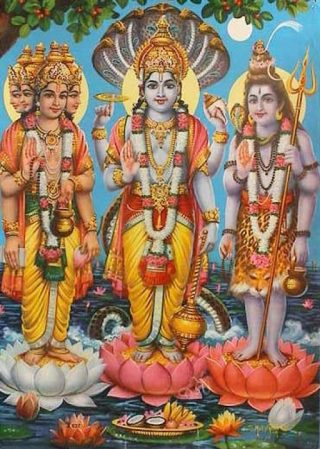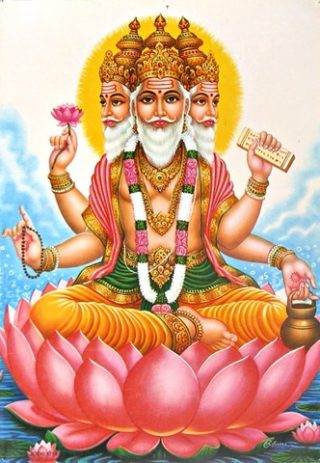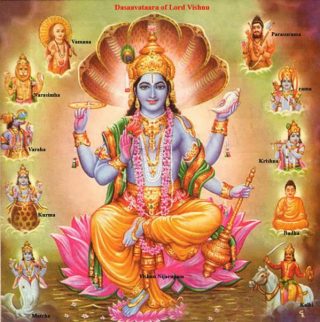Welcome to the world of Hinduism! As you know, Hinduism is a polytheistic religion, meaning that its followers believe in more than one god. In fact, worshipers commonly devoted

themselves to one god, their personal deity. Household shrines feature pictures and statues of the chosen gods. Individuals may choose this god for its special attributes. For example, Ganesh, the god with the head of an elephant, is known for overcoming obstacles and bringing success. The Rig-Veda introduced the foremost of the Hindu gods: Brahama, Vishnu, and Shiva. Although each of these deities possess special attributes, many Hindus believe they represent three properties of one god. Together they form the Hindu Trinity. This Trinity will be explored below!
Intended Learning Outcomes(ILOs):
- Describe each of the gods and goddesses of the Hinduism pantheon.
- Explain the relevance of the Hindu tradition to our everyday life.
The Hindu Trinity
Brahma: The Creator

Brahma is considered the mystical creator,the supreme presence, or God. Many Hindus believe that all other gods originate from Brahma. To the right is a depiction of Brahma. His four faces stand for the four corners of the universe. He holds a sacrifi-cial ladle, the four Vedas, a jar of holy water from the Ganges, and a necklace of prayer beads. Like all Hindu gods, he sits upon a lotus throne.
Shiva: The Destroyer

Shiva is worshiped as the destroyer or purifier. Like Vishnu, Shiva appears in many different forms throughout Hindu legends. However, the most widely known is that of Shiva Nataraja, the Lord of the Dance.
Shiva dances in a halo of fire, representing the cycle of birth and death. As he dances, he crushes the dwarf, the demon of ignorance. In his right hand, he keeps rhythm beating a drum, while in his left hand he holds the flame of destruction, purification, and renewal. His other hands are in a position of blessing or refuge. Around his arms and neck he wears deadly snakes. The snakes symbolize Shiva’s power over evil forces, while its ability to shed its skin makes it a symbol of fertility as well.
Finally, Shiva Nataraja is a symbol of sexual power and union. This is demonstrated by the female earring on his left ear and the male one on his right.
Vishnu: The Preserver

Followers of Vishnu worship him as the preserver, greatest of the gods. His role is to maintain a balance between good and evil powers in the universe. In order to do this, Vishnu returns to earth in different forms, both animal and human. Tradition holds that there are ten avatars, incarnations, linked to Vishnu. However, only Rama and Krishna remain the focus of worship among Hindus.
Here are the ten incarnations of Vishnu and the task each performed:
- Matsya (Fish): As a giant fish, Vishnu warned the world of a great flood, rescuing both a famous sage and the Vedas from the flood.
- Kurma (Tortoise): After the flood, Vishnu, in the form of a huge tortoise, retrieved the gods’ elixir of immortality, which was lost in the depths of the ocean.
- Varah (Boar): After the demon Hiranyakasipu plunged the earth into the ocean, Vishnu, in the form of boar, hoisted the world above water.
- Narasimha (Man-Lion): In order to destroy another demon, Vishnu became half-man, half-lion. This was because the demon, Hiranyakasipu, could be killed by neither animal nor man alone.
- Vamana (Dwarf): When Vishnu first came as a human avatar, he did so to outwit the ruling demon-king, Bali. As a dwarf, he convinced Bali to give him as much land as he could cover in three steps. Immediately,Vishnu transformed himself into a giant,striding across the universe.
- Parashurama (Rama with an axe): Vishnu returned as Rama with an axe to defeat the ruling warrior class and restore the Brahmins to power.
- Rama (Prince): As prince of Ayodya, Rama is the hero of the epic poem, The Ramayana.
- Krishna (Young hero and lover): Krishna is considered by many Hindus to be the most important avatar. Fleeing the King (his evil uncle), he was raised in a forest where he slayed many demons.Eventually, he killed his uncle and restored his kingdom. When he returned to the forest to battle demons, he was accidentally slain by the arrow of a follower. Krishna’s charm and power are the subject of many stories in Hindu mythology. Here he is in one of his famous poses, dancing upon the head of a tamed snake.
- The Buddha: The story of Prince Siddhartha, the Buddha, is told in full in The section on Buddhism.
- Kalki: Some Hindus believe Kalki will appear upon a white horse, yielding a flaming sword, at the end of time.
Relevance of the Hindu tradition to our everyday life.
The values that Hinduism promotes, such as mutual respect, compassion, and humility, throughout its teaching are essential for uplifting an individual’s self and help lay the foundation Hindu identity. Hinduism not only brings out religious beliefs and practices, but also a rich culture in language and the arts. By adopting the very basic principles of Sanatan Dharma, which include trust, humility, performance of duty, and effects of karma, the personality and lives of individuals can improve for betterment creating a positive environment around them. The scientific aspects of Sanatan Dharma have astonished the world by its theories and results. Mental and physical health can improve significantly through basic Vedic science and is widely used through this modern world. Finally Sanatan Dharma brings a sense of belonging and a unique culture through music, dance, and language which all Hindus should take pride in. The morals taught in Sanatan Dharma, modern use of Vedic teachings, and cultural diversity Sanatan Dharma brings, demonstrates how Hinduism is relevant to society, but Hindus must apply these teachings of this great Dharma to their everyday lives to make Sanatan Dharma relevant and successful.